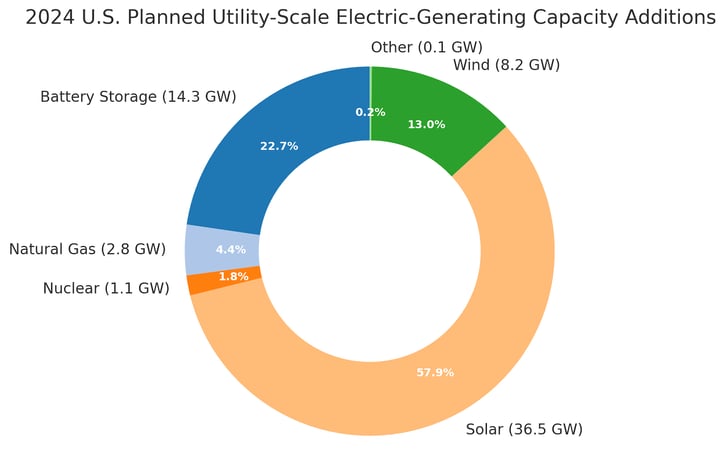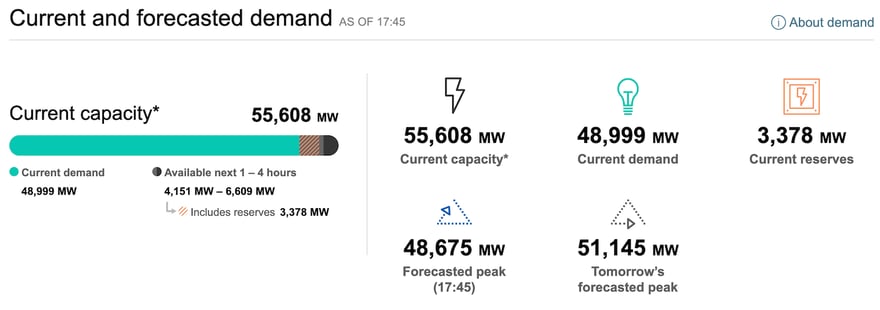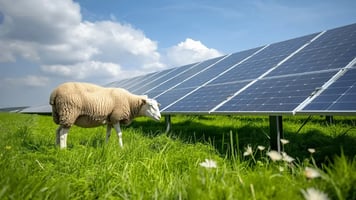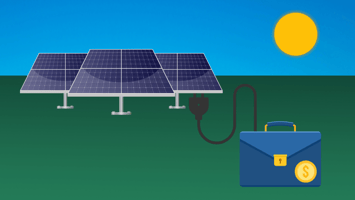The renewable energy sector, particularly solar energy, has experienced exponential growth over the...
Utility-Scale Solar: An Investment Opportunity
Before discussing investment opportunities in utility-scale solar, I’ll provide some background and information about the direction of this solar industry category.
Utility-scale solar is a power generation facility that provides energy to the electric grid.
Utilities typically have a broad mix of energy inputs from three categories — fossil fuels (coal, gas, oil), nuclear, and renewable. Renewable sources are hydro, wind, solar, biomass, and geothermal.
Of the renewable sources, large-scale hydroelectric projects are not considered green power by the EPA due to their environmental impact.
The U.S. Energy Information Administration predicts that solar PV will see the most growth among clean sources of electricity in the coming decades. The most common location for solar power plants is sunny areas that are remote but not too far from electrical transmission facilities. Semi-arid and desert climates are best.

Data Source: EIA Preliminary Monthly Electric Generator Inventory
Increasing electricity demands
California is an example of a market that relies heavily on renewable energy sources for in-state electricity generation. However, California's electrical grid becomes stressed when the state experiences extreme heat.
On Labor Day 2022, statewide electricity demand peaked at almost 49 gigawatts (49 billion watts). That's equivalent to 1,200 watts of energy being drawn simultaneously by every person in California. At regular times, 1,200 watts is closer to the average energy consumption by an entire household.

To avoid rotating power outages, California's Independent System Operator (ISO) had to conduct an extensive campaign in which California residents were asked to minimize their electricity consumption from 4 PM to 9 PM for several consecutive days.
The tight energy supply in California contributes to peak electricity prices as high as 49 cents per kilowatt-hour (kWh).
Because of these peaks in demand and relatively sunny conditions in the southwest part of the country, the number of residential, commercial, and utility-scale solar projects has been increasing.
How utility-scale solar power works
A utility-scale solar facility generates power from the sun and feeds it into the grid, supplying a utility with energy.
Almost every utility-scale solar facility has a power purchase agreement (PPA) with a utility. The agreement guarantees a market for the facility's solar energy for a fixed amount of time. However, an emerging trend with sizeable independent power producers (IPPs) is occurring: having their own energy trading desk. This enables the IPP to sell electricity at a higher revenue than typical PPAs on the spot market.
An increasing number of solar projects are using battery storage. Batteries are charged during daylight hours and supply the grid during peak usage hours, a process called ‘load-shifting,’ which results in additional solar project revenue.
As with many industries, solar technology continues to improve. Solar modules are more efficient than ever.
The Inflation Reduction Act of 2022 introduced production tax credits to accelerate U.S. manufacturing of batteries, solar panels, and other clean energy equipment.
The cost and reliability of utility-scale solar PV (photovoltaic) have fallen dramatically in recent years, and it is now cheaper than coal in many parts of the world.
How does PV solar compare to other types of generation plants?
In 2020, the average electricity consumption for a U.S. residential utility customer was about 893 kWh per month.
The capacity of an electricity-generating plant is measured by how many megawatts the facility can generate at peak.
Non-solar
The Dalles Dam on the Columbia River has a capacity of 1,878.3 megawatts (MW) of electricity production — enough to power 800,000 homes.
The Diablo Canyon Power Plant in San Luis Obispo County, California, is a nuclear facility with a capacity of 2,256 MW.
Solar
The Solar Star Project in Rosamond, California, has a capacity of 579 MW. 1.7 million solar panels stand on over 3,200 acres. This is currently the largest solar farm in the United States, with enough energy to power 255,000 households.
The Gemini Solar Project in Nevada plans to begin operating in 2024. The planned photovoltaic capacity is 690 megawatts (MW), and battery storage is 380 MW. When it's fully operational, this is expected to be the largest solar project in the United States. The project is located on BLM (Bureau of Land Management) land 25 miles northeast of Las Vegas, south of Interstate 15.
How big can solar plants get?
The Bhadla Solar Park in India is the largest solar power plant in the world. It has an installed capacity of 2250 MW, equal to California's Diablo Canyon nuclear plant. To support this electricity production level, the size of the facility is a whopping 14,000 acres.
Today, PV solar accounts for under 3% of utility-scale electrical generation in the United States. However, the U.S. Energy Information Administration expects the percentage to increase to 20% by 2050.
Here is a visualization from Berkeley Lab’s “Utility-Scale Solar, 2023 Edition” showing PV capacity and generation percentage by state from 2007 through 2022.
Land requirements
New grid-connected solar projects require acreage—and a lot of it. Therefore, land developers play a role in this phase of a solar project.
This Google Maps view of Solar Star shows the overall footprint of the solar arrays.
If you've flown over the U.S., you've seen how much land we have. So, the land itself is not a scarce resource, but time and money are required to purchase and assemble enough contiguous acreage.
In some cases, land previously used for crops with water requirements that can no longer be fulfilled is now available for a solar farm with a lower water use.
The investor opportunity
Solar power is one of several solar energy opportunities available to accredited investors.
The construction of solar power plants is expensive and typically requires financing from institutional investors.
However, there is an excellent opportunity for private investors on the front end to invest in land development.
The project sponsor manages land acquisition and contracts. Investors provide capital in exchange for passive income, such as interest on a personally guaranteed promissory note.
Accredica has provided solar investment opportunities in the commercial and nonprofit sectors for over a decade. We have applied our domain knowledge and expertise to solar power plants.
Accredica offers clean, sustainable energy investment opportunities for our utility-scale solar projects in the Arizona and Nevada deserts.
Charles Schaffer
President and Founder, Accredica
Charles has founded and operated several development companies over his 35+ year history to pursue his passion for Alternative Investing. He believes outsized returns can be achieved without a corresponding increase in risk. Under Charles' leadership, Accredica has developed and financed over $160 million of commercial real estate and renewable energy projects.




